Unforgotten Valor
Charles Kettles earns Medal of Honor nearly 50 years after Vietnam heroics
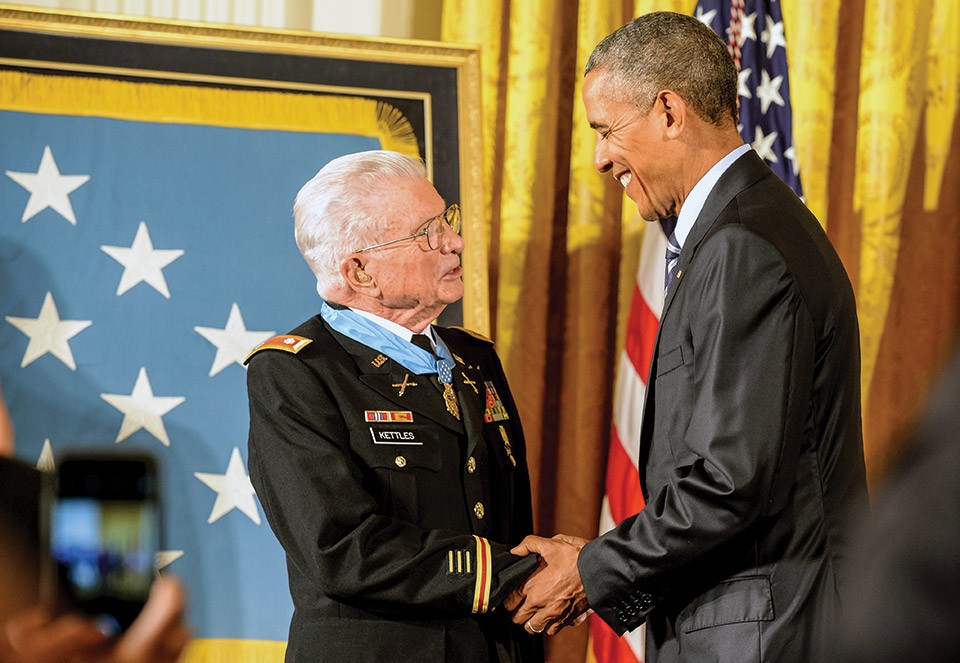
For several decades, the remarkable story of Charles S. Kettles’ heroism in 1967 during the Vietnam War was not widely known.
His family and closest friends knew, and so did the military comrades who served with him in Vietnam. After he left the U.S. Army as a Lieutenant Colonel in 1978 and returned home to Ypsilanti, the tight-knit band of veterans in Washtenaw County learned the basics of his story, but most of the local community had no idea.
Kettles (MS79) went about his post-military life with the quiet efficiency the military had taught him. He returned to Eastern Michigan University, earned a master’s degree, started EMU’s aviation program and taught there for several years, served on the Ypsilanti City Council and eventually worked for an aviation company before retiring in 1993. Over the 23 years of his retirement he continued a low-key existence with his wife, Ann, at their home a few blocks from the EMU campus.
On July 18, 2016, things changed in a big way. That’s the day Kettles stood before a large audience in the East Room of the White House as President Barack Obama presented him with the Medal of Honor, the nation’s highest military decoration for valor. National media coverage gave Americans the dramatic details of how Kettles, the pilot of an Army helicopter, led a rescue of 44 soldiers during an intense battle on May 15, 1967, along the Song Tra Cau River near Duc Pho, Vietnam.
“Even now, all these years later, Chuck is still defined by the humility that shaped him as a soldier,” President Obama said as he summarized the life and service of the 86-year-old veteran.
The president noted that Kettles is the son of Canadian immigrants; that his father signed up to be a pilot for the U.S. military the day after the Pearl Harbor attack; that Kettles and a brother ran a Ford dealership that put cars in the driveways of many Michigan families.
“So in a lot of ways, Chuck Kettles is America,” the president said. “And to the dozens of American soldiers that he saved in Vietnam half a century ago, Chuck is the reason they lived and came home and had children and grandchildren—entire family trees made possible by the actions of this one man.”
National spotlight
One sunny Saturday morning early this fall, a couple of months after the trip to Washington to receive the medal, Kettles sat with Ann in the living room of their comfortable home, earnestly answering questions from yet another interviewer among the many who have requested his time in recent months.
Military and government officials needed to check facts and confirm timelines as they prepared the Medal of Honor presentation and created a multi-media website devoted to it. Local, state and national publications have helped spread his harrowing and heroic story across the country. Friends at the Ypsilanti Historical Society did a story on the Medal of Honor initiative, drawing on interviews and old photos dug out of their basement.
The four-day trip to Washington included a second ceremony at the Pentagon the day after the one at the White House, press conferences, video interviews and photo sessions. The days were intense but the itinerary and organization were “extremely well done,” Kettles says. Most of Kettles’ blended family—Charles has six children and Ann has four—attended, as did a group of local friends and veterans, some of whom were saved by his actions.
The Medal of Honor Society prepared Kettles to expect personal appearance invitations from organizations around the country. In addition to a local reception at Willow Run Airport, he and Ann have gone on several trips—to an air museum in Topeka, Kansas; to Fort Wolters, Texas, and to Minneapolis for the annual reunion of Medal of Honor recipients.
“It just keeps going,” he says of the attention. “An awful lot of them are still asking. And, frankly, I don’t understand why there is such a broad interest in this thing.” Or, as President Obama quoted Kettles as saying, “It seems like a helluva fuss for something that happened 50 years ago.”
Intense hostile fire
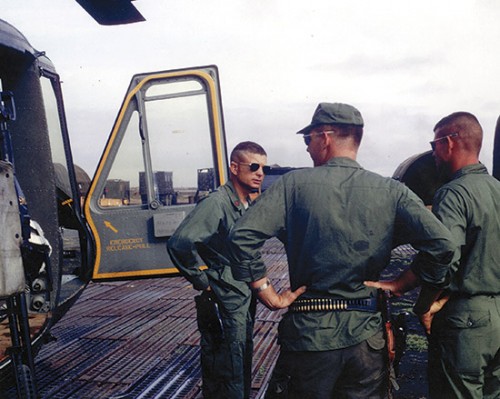
What happened on that day a half-century ago is both well-documented and hard to forget.
When 101st Airborne troops were ambushed by a much larger force of the North Vietnamese Army, then-Major Kettles volunteered to lead six helicopters to carry reinforcements and evacuate the wounded. They were under heavy attack at the landing zone, with soldiers killed before they could leave the helicopters. Kettles waited until all the reinforcements and supplies were off-loaded and wounded personnel were aboard before he returned to the staging area.
The helicopters picked up more reinforcements and made a second trip to the site of the battle. Kettles’ helicopter was hit, seriously wounding his gunner. Fuel streamed out of his helicopter as he flew back to base.
Later in the day, the infantry commander requested an immediate extraction of the remaining 40 troops in addition to four flight crew members whose helicopter had been destroyed. Kettles volunteered to lead another unit of six helicopters to evacuate comrades pinned down at the landing zone. Again under withering fire, the helicopters took aboard the troops and took off, believing all the soldiers had been retrieved.
Shortly after lifting off, however, Kettles learned that eight soldiers were still on the ground. As the others continued back to base, he turned back to the landing zone for a fourth time. With no gunship or artillery support, the lone helicopter became the sole target of the North Vietnamese. As he landed, a mortar round shattered the front windshields and the “chin bubble” of the aircraft. The tail and other parts of the helicopter were hit by heavy fire. The eight soldiers on the ground somehow scrambled aboard, joining the crew of four and one soldier who had been rescued on the previous landing. Kettles skillfully coaxed the damaged and seriously overloaded helicopter off the ground in a series of hops along a nearby dry riverbed at the edge of the landing zone.
Baptism in war
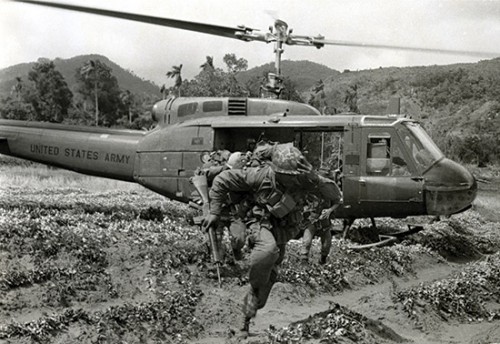
Forty-nine years later, as Kettles stands in a room in his home filled with helicopter and aircraft models, photos and other military memorabilia, he remembers the chaos. He breaks into a technical discussion of what he did to get the helicopter off the ground that day—explaining lift and rotor RPMs and an emergency panel that was “cold,” meaning no red lights to indicate engine failure or any of a hundred problems that could have kept the machine on the ground.
“Because of the terrain, I simply had to bounce along,” he says. “It was too rough to make a running departure. It was a dry river bed, just a trickle of water and a kind of white gravel for the most part. That’s where I went over and bounced down the river bed because it was smoother than the terrain.”
He’s asked if he ever thinks about the staggering odds against his success that day. “Lucked out,” he says, with a slight shrug.
“As the scene progressed, you just respond to the change in the situation. Whatever needed to be done. It didn’t seem to me that it took great talent. This is what the situation is here and here and here,” he says motioning to different spots on the imaginary battlefield. “Just respond to it as it seemed appropriate. I just regarded it as a baptism in war.”
Other people regarded it as something much more. Almost immediately, some who were there that day said he deserved the Medal of Honor. What he received instead was the second highest medal the military awards—the Distinguished Service Cross. He received another high commendation—the Distinguished Flying Cross—for a separate rescue maneuver one day before his more famous action.
There doesn’t seem to be a consensus on why he was not awarded the Medal of Honor within the required five years. But six years ago, William Vollano, a retired social worker from Ann Arbor, interviewed Kettles as part of the Ypsilanti Rotary Club’s Veterans History Project. Vollano, convinced that Kettles deserved the Medal of Honor, worked with Kettles’ son, Mike, of Dallas, Texas, to gather documents and interviews to influence the Pentagon and Congress. They received help from Michigan Congressman John Dingell and later his wife, Congresswoman Debbie Dingell. Once the Pentagon approved it, a one-time provision waived the five-year statute of limitations.
Baggage handler turned Huey pilot
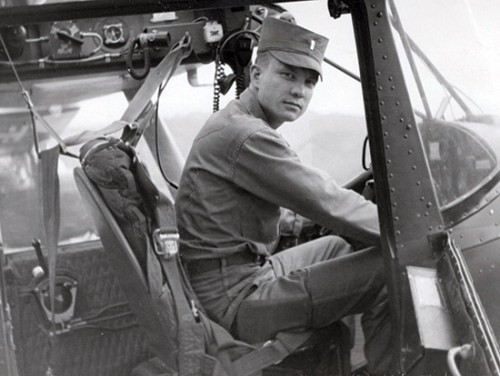
Kettles’ connection to Eastern Michigan University has two parts, separated by 30 years. After graduating from the Edison Institute high school in Dearborn, he enrolled at Michigan State Normal College in the fall of 1949. He considered pre-med, but settled on pre-engineering. He remembers as a freshman having to wear “a stupid green cap, which didn’t appeal to me at all.”
He lived off campus with two aunts at their home on Normal Street, and worked nights as a baggage handler for American Airlines at Willow Run Airport. He needed the job to pay his tuition, but it led to what he calls “less than sterling” grades. By the fall of 1951, he had taken on a second job and planned to sit out the fall term, saving up enough money so that he wouldn’t have to work during the spring term and could improve his grades.
“But then they sent me a draft notice. Actually, I was quite relieved,” he says, comparing his new Army routine to his night shifts at Willow Run. “I thought it was a helluva good deal because (the Army) wouldn’t get me up much before 5:30 or 6 in the morning, and they’d let me go to bed by not later than 10 at night. They took care of my laundry and I knew where I was going to eat. And they even paid me a little bit of money—I think it was $83 a month.”
He received flight training and got to Korea a few months after the war there had ended. After stops in Japan, Thailand and assorted U.S. bases, his commitment was up in 1956 and he returned to Michigan. He joined the Army Reserve in Lansing and ran an auto dealership in Dewitt with one of his brothers.
By 1963, with the U.S. involved in Vietnam, the military “was screaming for pilots,” he said, and he went back on active duty. He made the transition from fixed-wing pilot to helicopter pilot, mastering the iconic Huey. He landed in Vietnam in February 1967, three months before the battle that led to the Medal of Honor, and stayed through November. His second tour of Vietnam was a full year from 1969 to 1970. He then returned to the States, moving up the ranks until his retirement from the Army in 1978.
A program is born
The previous year Charles had married Ann, who lived next door to his aunts’ house. She worked at EMU and they settled in Ypsilanti as Charles re-engaged with the University. He recalls that his 30-year-old undergraduate records were found in storage in a furnace room.
“It’s too bad they didn’t burn them because I think they would have done both of us a favor if I had just started over again,” he says.
He took a few credits to complete his undergraduate degree from a college in San Antonio, Texas. He then enrolled at EMU to work on his master’s degree in commercial construction from the Department of Industrial Technology. He completed the degree in December 1979 and was later hired as an assistant professor.
During that time, EMU was expanding its curriculum beyond its long-established teacher training programs. Kettles inquired about starting an aviation management program at EMU. Working with Alvin Rudisill, the College of Technology’s new dean, and Jeff Luftig, an industrial technology professor, Kettles put together an extensive prospectus.
This was not a pilot-training program; it was about preparing students to manage aviation businesses or work in other aviation jobs. There were already lots of flight schools, but far fewer places to develop aviation managers. The new courses included Aircraft Maintenance Management, Aviation Ground Instruction, Aviation Law and Insurance, Flight Operations and Management, Aviation Safety and Accident Investigation, Personnel Management and Weather Reporting and Analysis.
“Historically, in aviation, pilots have been put into management positions (but) good pilots or excellent pilots did not necessarily make the best managers,” Kettles says. The University approved the program, and from 1982 through 1986 Kettles taught some of the courses and sought out instructors.
He quickly discovered that academia was much different from the military. He laughs when he recalls an early faculty meeting where he learned that rank-and-file members of the department would rate the head of the department.
“‘Collegiality’ would not be a term you would use in the military,” he says. “You wouldn’t know what it was. We knew who the boss was. We were not evaluating the boss.”
He stayed with the program, but eventually found a position with an aviation component of Chrysler Corporation, where he worked for nine years until his second, non-military retirement in 1993.
The aviation program is still a part of EMU and has expanded to include flight instruction. “It survived. It just wasn’t designed for me—not to lead it,” he says.
44 names
Kettles retains the humble, look-you-in-the-eye demeanor that family and friends have known for decades. He remains Ann’s chief assistant when she calls his cellphone from another part of the house in need of assistance moving about in her wheelchair. And he still has coffee most mornings with a group of long-time buddies.
As he has from the beginning, he regularly acknowledges that he didn’t act alone on that day in Vietnam. He points out that 74 pilots and crew members completed their jobs selflessly and valiantly. He often says in interviews and speeches that the most important thing about that day is that 44 names were kept off the Vietnam Veterans Memorial wall that lists the 58,000 men and women killed in action during the war.
Near the end of an interview, when Charles mentions again that he doesn’t understand the intensity and longevity of support his story has drawn, Ann reminds him of something that President Obama said during the medal ceremony. Referring to a difficult summer of police shootings, terrorism and other depressing news, the president noted that celebrating goodness and decency and helping each other when times are tough is “a wonderful inspiration” for the American people. Ann said people from all over the country have been calling Charles because his story is “good news.”
Charles nods to acknowledge her view, then walks away for a moment to retrieve a book of photos from their trip to Washington.
“He’s a national hero,” Ann says quietly.
Charles doesn’t respond. His actions spoke for themselves on May 15, 1967.
Contact Darcy Gifford, dgiffor2@emich.edu , 734.487.5375

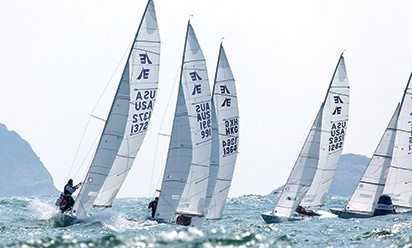 Championships place Skip Dieball among the world’s elite sailors
Championships place Skip Dieball among the world’s elite sailors
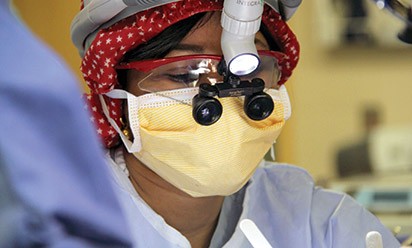 Dr. Oluwaseun Adetayo’s career as a plastic surgeon is bringing smiles to people’s faces… literally.
Dr. Oluwaseun Adetayo’s career as a plastic surgeon is bringing smiles to people’s faces… literally.
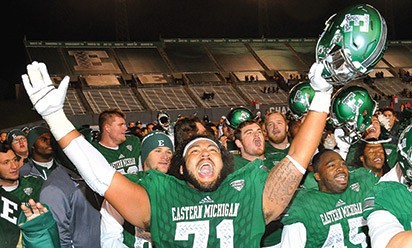 Eastern football has its most successful season in decades
Eastern football has its most successful season in decades